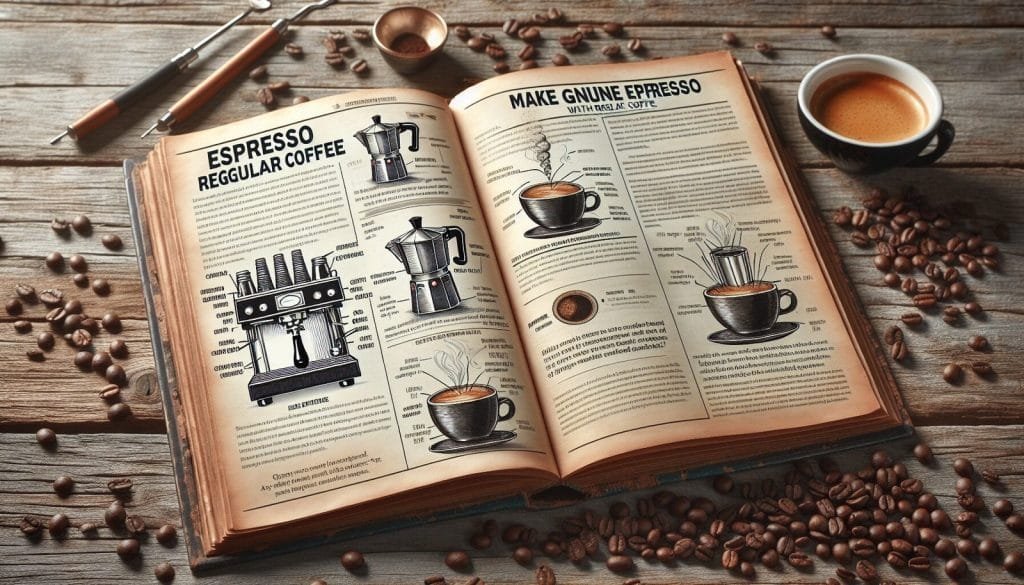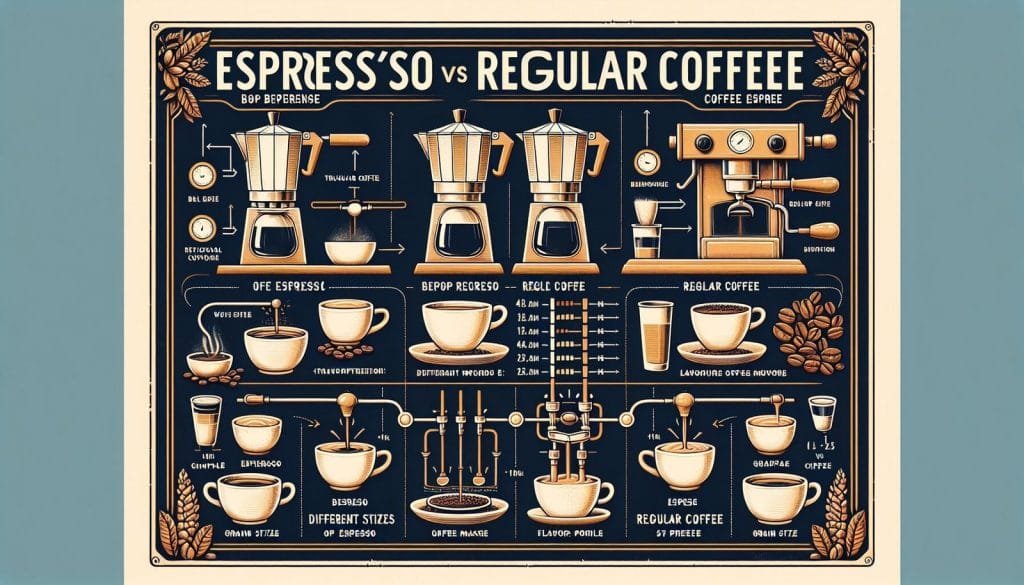Espresso, a concentrated form of coffee known for its rich flavor and velvety texture, has captivated the taste buds of coffee lovers around the world. But have you ever wondered if it is possible to recreate this beloved beverage using regular coffee? In this article, we will explore the feasibility of making espresso with coffee and delve into the key differences between the two. So, put on your academic hat and prepare to uncover the truth behind this intriguing query.

Understanding Espresso and Coffee
Espresso and regular coffee are two distinct beverages with different brewing methods and taste profiles. Espresso is a concentrated form of coffee that is brewed using high pressure and finely ground coffee beans. It is typically served in small amounts, known as shots, and has a rich, intense flavor and a layer of crema on top. On the other hand, regular coffee is brewed by steeping coffee grounds in hot water and is usually served in larger quantities. It has a milder flavor and lacks the creamy texture and strong intensity of espresso.
Differences Between Espresso and Regular Coffee
The main differences between espresso and regular coffee lie in the brewing methods and the resulting taste profiles. While regular coffee is brewed using gravity and a longer extraction time, espresso is brewed under high pressure for a short duration. This high-pressure brewing process leads to the extraction of more oils, flavors, and caffeine from the coffee grounds, resulting in an intense and highly concentrated beverage.
Furthermore, the consistency and texture of espresso are quite different from regular coffee. Espresso has a creamy layer on top, known as crema, which is created by the emulsification of oils during the brewing process. This adds a velvety mouthfeel and enhances the overall sensory experience of espresso. Regular coffee, on the other hand, lacks this crema and has a smoother and less concentrated consistency.
Traditional Espresso Brewing Method
The traditional method of brewing espresso involves using an espresso machine. This machine heats water to an optimal temperature, typically between 195 to 205 degrees Fahrenheit, and then forces it through finely ground coffee beans using pressure. The water is forced through the coffee grounds at a high pressure of around 9 bars, extracting the flavors and oils quickly and efficiently. The result is a concentrated shot of espresso with a layer of crema on top.
Ingredients for Making Espresso
To make traditional espresso, you will need a few essential ingredients:
-
Coffee Beans: Choose a high-quality, dark roast coffee specifically labeled for espresso. Opt for freshly roasted beans to ensure optimal flavor.
-
Water: Using filtered water is crucial to prevent any impurities or chemicals from affecting the taste of your espresso. The water should be heated to the appropriate temperature mentioned earlier.
-
Grinder: A burr grinder is recommended to achieve a consistent and fine grind size. This is important for proper extraction during the brewing process.
-
Espresso Machine: An espresso machine capable of generating adequate pressure is necessary for traditional espresso brewing. Manual, semi-automatic, and automatic machines are popular options.

Can Regular Coffee Be Used to Make Espresso?
While it is tempting to attempt making espresso using regular coffee, it is important to note that true espresso cannot be replicated solely with regular coffee. The brewing process and equipment necessary for espresso are specifically designed to produce a distinct flavor and crema layer that regular coffee cannot emulate. However, there are alternative methods that can mimic the essence of espresso using regular coffee as a base, which we will explore later.
Pros and Cons of Using Regular Coffee for Espresso
Using regular coffee to make espresso-style drinks has both advantages and disadvantages. On the positive side, regular coffee is more accessible and affordable compared to specialty coffee beans specifically marketed for espresso. This allows for experimentation and the opportunity to create espresso-like beverages at home without investing in expensive equipment.
However, using regular coffee may result in a beverage that falls short of the true espresso experience. Regular coffee lacks the fine grind size necessary for optimal extraction under high pressure, leading to a weaker and less concentrated shot. Additionally, the absence of the characteristic crema layer may disappoint those seeking a true espresso taste.
Alternative Methods to Make Espresso with Coffee
For those who still wish to create espresso-like drinks using regular coffee, alternative methods like the Moka pot and AeroPress can help achieve a concentrated and robust flavor reminiscent of real espresso. These methods utilize pressure and water to extract more flavor and intensity from the coffee grounds.
The Moka pot, also known as a stovetop espresso maker, works by heating water in the bottom chamber. As the water heats up, pressure builds, forcing the hot water through the coffee grounds in the middle chamber and into the top chamber, creating a concentrated, espresso-like beverage.
The AeroPress, on the other hand, uses air pressure to extract flavors from the coffee grounds. It involves steeping coffee grounds in hot water, then applying pressure through a plunger to create an espresso-style shot of coffee.
While these alternative methods cannot replicate the exact flavors and characteristics of traditional espresso, they can provide a strong and flavorful coffee concentrate that can be used as a base for various espresso-based drinks.
Tips for Making Espresso with Coffee
If you decide to use regular coffee and one of the alternative brewing methods to create espresso-style drinks, here are some tips to ensure the best possible result:
-
Grind your coffee finer than you would for regular drip coffee. This allows for increased extraction and helps to achieve a more concentrated flavor.
-
Adjust the brewing time and temperature according to the alternative brewing method you choose. Different methods have different optimal conditions for extracting coffee flavors.
-
Experiment with coffee-to-water ratios to find the balance that suits your taste preferences. Different ratios will result in varying levels of strength and intensity.
-
Preheat your equipment and cups to ensure the beverage stays warm for longer and maintains a consistent temperature throughout the brewing process.
Recommended Coffee Beans for Espresso
If you are looking to make authentic espresso using an espresso machine, it is advisable to invest in high-quality coffee beans specifically curated for espresso brewing. Look for dark roast beans that are rich in flavor and have been specifically roasted and blended for espresso. Some popular options include Italian roast, French roast, and espresso roast blends.
Make sure to source freshly roasted beans to ensure the best possible flavor. Additionally, consider purchasing whole beans and grinding them just before brewing to preserve the aroma and freshness.
Conclusion
In conclusion, while regular coffee cannot be used to replicate true espresso, alternative brewing methods can produce espresso-like drinks using regular coffee as a base. The Moka pot and AeroPress offer pressure-based techniques that extract more flavor and intensity from the coffee grounds, allowing for a strong and concentrated beverage. However, for those seeking an authentic espresso experience, investing in an espresso machine and using high-quality coffee beans specifically roasted for espresso brewing is the best route. The distinct flavor, crema layer, and intense concentration characteristic of espresso can only be achieved through the proper equipment and brewing techniques. So, while you may not be able to make true espresso with regular coffee alone, you can still enjoy espresso-like drinks with alternative methods and a little experimentation.




